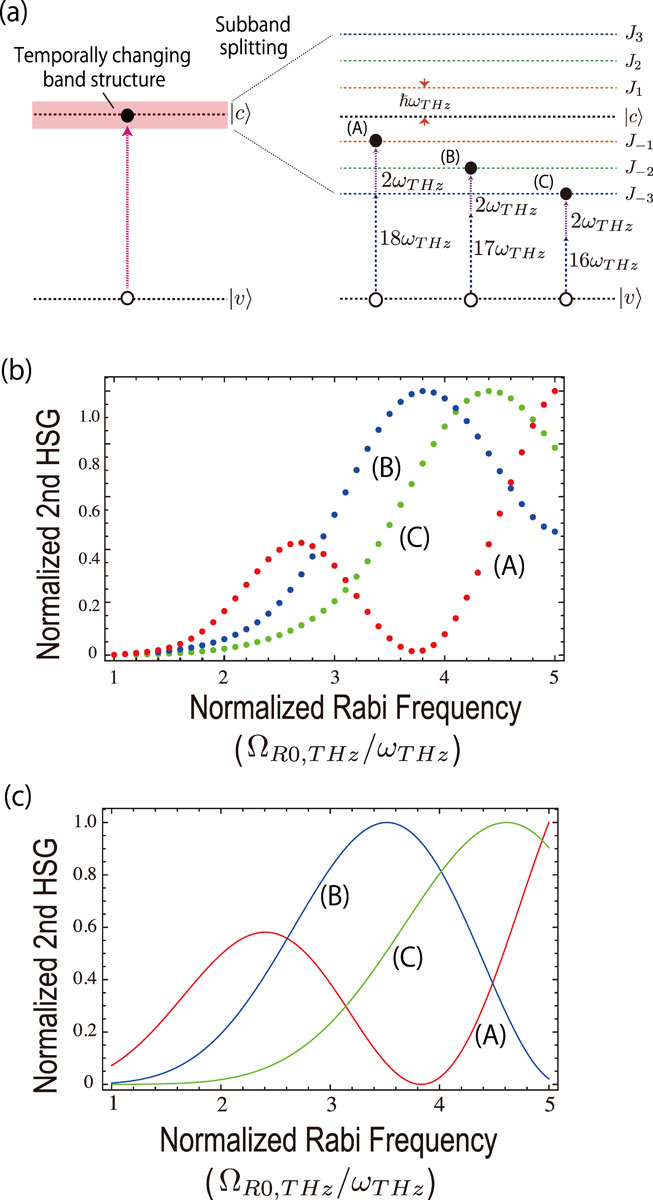High-Harmonic Generation in Solids
Kato Group
Recently, high-harmonic generation (HHG) in solids has been experimentally observed. In contrast to that of the gaseous media, solids have the vastly diverse nature such as in their band structures, energy gaps, crystalline anisotropy, magnetism, and so on. Thus, HHG shows various properties depending on the materials, and clarifying the universal properties of HHG in solids should be needed to progress the high-intensity optical technology.
Based on this motivation, we have theoretically investigated HHG mechanism in solids. In Ref. [1] and [2], we have shown that the HHG mechanism can be classified into three regimes depending on the field intensity: (i) the multiphoton absorption regime, (ii) ac Zener regime, and (iii) semimetal regime. This consideration enables us to predict that HHG in graphene would show unique properties in its ellipticity dependence, and this was identified in the experiment [3]. In this consideration, a concept of the field-induced dynamic band structure is essential to gaining a full understanding of extreme nonlinear optics in solids. Although fundamental mechanisms of HHG in solids have already been revealed [3], the connection between HHG and other high-field phenomena, such as the dynamical Franz-Keldysh effect, above-threshold ionization, and dynamical localization has not been clarified yet. It appears that HHG and these optical phenomena are different aspects of the same electron interaction with the strong light field. We tried to clarify the relation between HHG and these phenomena, by supposing the pump-probe spectroscopy where weak near infrared (NIR) and strong terahertz (THz) light are simultaneously imposed.
The weak NIR and strong THz lights induce the high-order sideband generation (HSG), which changes depending on the THz intensity and NIR frequency. These changes are considered as a probe of the modified states of solids under strong THz light irradiation. Figures 1 (a)-(c) show the intensities of 2nd positive and negative HSG as a function of NIR frequency (ωNIR) for different THz intensities (ΩTHz). These figures indicate that with increasing the THz intensities, more peaks at different frequencies of ωTHz become visible, which reflects the modified state of the system has new energy levels around the band-gap energy. By an analytical consideration, we have shown that these energy levels (subbands) are derived from a concept of the field-induced dynamic band structure, as shown in Fig. 2(a). We have also shown that kth Bessel function, ΩTHzJk(ΩTHz/ωTHz), effectively describes mixing matrix elements between the kth subband and the valence band, which can be used for a rough estimate of the transition amplitude. This presumption could be identified by numerical calculation, as shown in Fig. 2(b), where the positive 2nd HSG resonates to subbands with their energy levels Eg = 20ωTHz, Eg = 19ωTHz, and Eg = 18ωTHz, respectively (see Fig. 2(a)). These non-monotonic properties are generally confirmed in other high-field phenomena such as the dynamical Franz-Keldysh effect and dynamical localization. Thus, we could clarify the relationship between HHG and other high-field phenomena and suggest a new experiment for identifying oscillatory behavior that would be observed in field-intensity dependence of HHG in solids [5].

Fig. 2. (a) Schematic diagram of the subband picture originating from temporally changing band structure. (b) Numerical results of positive 2nd HSG as a function of ΩTHz/ωTHz. Here, the red, blue, and green dots indicate (A) ωNIR = 18ωTHz, (B) ωNIR = 17ωTHz, and (C) ωNIR = 16ωTHz, respectively, whose processes are illustrated in (a). Inset figure: Analytic results of 2nd HSG as a function of ΩTHz/ωTHz. The red, blue, and green lines show |xJ-1(x)|2, |xJ-2(x)|2, and |xJ-3(x)|2, respectively, where x = ΩTHz/ωTHz.
References
- [1] T. Tamaya et al., Phys. Rev. Lett. 116, 016601 (2016).
- [2] T. Tamaya et al., Phys. Rev. B 94, 241107(R) (2016).
- [3] N. Yoshikawa, T. Tamaya, and K. Tanaka, Science 356, 736 (2017).
- [4] T. Tamaya and T. Kato, Phys. Rev. B 100, 081203(R) (2019).
- [5] P. Xia*, T. Tamaya*, C. Kim, F. Lu, T. Kanai, N. Ishii, J. Itatani, H. Akiyama, and T. Kato: arXiv:2004.04492. (*equally contributed)

